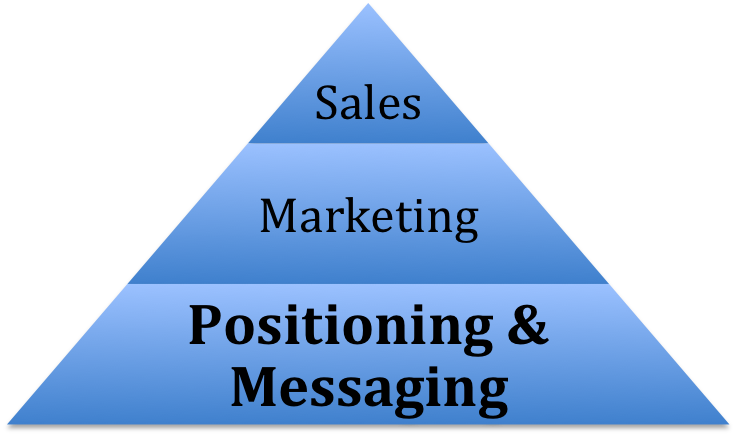The Positioning & Messaging Framework
How to get your message across, consistently, again and again…
What is a positioning & messaging (P&M) framework? Why should you care? Depending on the age/maturity of your company, it can be both an enlightening and contentious exercise for your leadership team. It is however, a critical step in the development or re-branding of your company and its product(s).
Here’s why:
Imagine you are the developer of a great new idea. It’s your brainchild and you believe it has the potential to change peoples’ lives. It has several key features, but you know that it’s real strength lies in one feature in particular. You develop your product accordingly. Now your partner, the one temporarily in charge of marketing and sales, sees market trends that she believes point to a different feature. She puts her focus, time and energy into crafting materials that focus on that feature.
A few months ahead of the launch, your investor comes to you with a must-have feature and he will not budge on the importance of this addition. You quickly switch gears, go heads down and expend the time and energy it takes to add this feature.
Meanwhile, your partner is juggling a myriad of tasks while you are heads down, so she hires a sales & marketing guru. He tests the product and identifies a completely different feature – one that will benefit a larger audience. He’s the guru after all, you are heads down and your partner? She defers to the guru.
The week ahead of the launch, the investor has what he needs, so you set the launch date and task the guru with drafting a press release. What he gives you doesn’t reflect the initial breakthrough feature, nor does it include the new feature your investor insisted upon. Where did it all go so wrong? How did your team lose sight of the initial and most important goal – the feature that will change peoples’ lives?
This scenario is a key example of why a positioning & messaging framework is essential for any startup, entrepreneur or even an established business looking to re-brand itself. The P&M exercise forces you and your partners/stakeholders, to reflect and agree upon what is being developed, who it is for, why it’s important to the market and what makes it stand out from the competition.
Without a unified positioning and messaging framework, your team will lack a solid understanding of key elements, elements that are vital to a successful, sustainable business.
Companies that miss this critical step find themselves struggling to develop cohesive marketing materials, website messaging and sales tools. As we can see from the example above, in the throes of creation it can be easy for your team to stray into new directions. The P&M process brings together all initial stakeholders in order to agree upon and better communicate the offering.
The Foundation of Any Successful Business
I like to think of the P&M Framework as the foundation of any business pyramid. It is an essential tool in your business toolkit because it informs all future content including your business plan, marketing collateral, personas, keywords, online content, investor and sales materials and thought leadership messaging.

For startups and entrepreneurs, developing this Framework for your constituents and team members is key before sharing your story and business objectives with investors. It should reflect the very essence of your business without flowery, descriptive words.
Here are a few of the important places you will see your Messaging at work.
Website Copy and Thought Leadership Materials
The P&M Framework not only provides short descriptions of your business, but depending on the offering, it also details the features and benefits of the product or service. Having this information available to your team ensures consistent messaging within the body of all website content, blogs and content generation by company thought leaders.
Search Engine Results and Rankings
The development of appropriate keywords is paramount in today’s web-centric world. Additionally, the “Meta Description,” is how your users (and more importantly search engines such as Google) will find you once you put up a website.
Below is an example of how important a one or two sentence description becomes when informing the reader.

Note the paragraph of data that comes up below the web address. Some websites auto-populate this whenever a new page or post is added to your website. However, any good Webmaster knows the importance of making sure this information taps into pre-determined, rich keywords and short descriptions about the business.
Social Media Websites
Whether you use LinkedIn, Twitter, Instagram or Facebook, you must have a 1-2 sentence description of your business. It is important to have this information at hand for consistent messaging across all platforms.
Sales & Marketing Content and Collateral, (even your logo)
While sales collateral may change, key features and benefits that come from your official P&M Framework should always be incorporated into any piece of content. Branding, messaging and keywords are essential for maintaining a consistent look and feel.
Media Relations and Press Releases
Making sure the press are clear on the five “W’s” of any good story, (Who, What, Where, When and Why) is only the first step when announcing news. More importantly, if you plan to release your news through a wire service such as PR Newswire or BusinessWire, having keywords and SEO built into the heading, subhead and first paragraph of your release is critical to getting your message seen by your target audience.
Additionally, all releases that go on the wire require a “boilerplate” or succinct description of your business and its offering. Remember that newswire organizations charge by the word. Keeping that boilerplate down to 3-4 sentences will keep your costs down.
Begin at the Beginning
Proper positioning and messaging is the first step in defining your business right from the start.
Before you share your idea with investors, speak to the press, or launch a new product, take the time to have a Positioning and Messaging Framework developed. Make sure your entire team is on board and understands the goals and objectives you and your partners have detailed, as well as the essential features and related benefits you want to convey. Then review that framework as your business goals change. In doing so, you will better ensure that your message will be associated with your brand, no matter where it appears.
Learn more by contacting [email protected]

